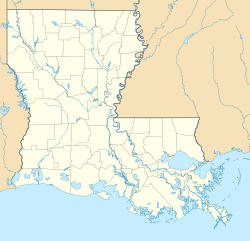Little Pecan Island Site facts for kids
| Location | Grand Chenier, Louisiana |
|---|---|
| Region | Cameron Parish, Louisiana |
| Coordinates | 29°47′41.676″N 92°47′37.896″W / 29.79491000°N 92.79386000°W |
| History | |
| Founded | 800 CE |
| Abandoned | 1100 CE |
| Cultures | Coastal Coles Creek culture |
| Site notes | |
| Excavation dates | 1946 |
| Archaeologists | Robert Wauchope |
| Responsible body: private | |
The Little Pecan Island Site (also known as 16 CM 43) is an ancient place where Native Americans lived a long time ago. It's an archaeological site from the Coastal Coles Creek culture. People lived here between the years 800 and 1100 CE. This special spot is found near Grand Chenier, Louisiana in Cameron Parish. In 1946, an archaeologist named Robert Wauchope studied the site. His work helped us learn about the age of the site and the culture of the people who lived there.
Contents
What is the Little Pecan Island Site?
The Little Pecan Island Site is a place where archaeologists find clues about the past. It's located on a low, sandy ridge. This ridge is about 3 miles (4.8 km) long. It is less than 1,500 feet (457 m) wide at its widest point. Little Pecan Lake surrounds the site on its north and east sides. The site is about 5 miles (8 km) northeast of Grand Chenier Ridge.
Who were the Coles Creek People?
The people who lived at Little Pecan Island were part of the Coles Creek culture. This culture was a group of Native Americans who lived in the lower Mississippi River Valley. They lived from about 700 to 1200 CE. The Coles Creek people were known for their unique pottery. They also built large earthen mounds. These mounds were often used for ceremonies or as platforms for important buildings.
Daily Life at Little Pecan Island
Life at Little Pecan Island would have been connected to the water. The site's location near Little Pecan Lake meant easy access to resources. People likely fished, hunted, and gathered plants. The sandy ridge provided a dry place to build homes. The lake would have been important for travel and trade.
Discovering the Past: Archaeology
In 1946, an archaeologist named Robert Wauchope investigated the Little Pecan Island Site. Archaeologists study old sites to learn about how people lived long ago. Wauchope found several burials at the site. He also studied the pottery pieces. By looking at the styles of pottery, archaeologists can figure out when a site was used. This helps them create a timeline of human history. The discoveries at Little Pecan Island helped us understand the Coles Creek culture better.


